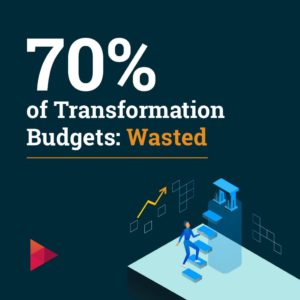The 7 “T’s” of Product-Led Transformation

 Transformation is a word that isn’t commonly favored by the Product community because Transformation Programs rarely allow Product Teams to autonomously decide how they’ll achieve their mission.
Transformation is a word that isn’t commonly favored by the Product community because Transformation Programs rarely allow Product Teams to autonomously decide how they’ll achieve their mission.
However, Transformation Programs incur significant costs. According to the CIO magazine, Global spending on digital transformation technologies and services was $1.3 trillion in 2020 of which 70% of that spend is wasted. That is approximately $900 billion.
Why Product Managers should care?
Great Product Management can, without a doubt do better with the $900 billion squandered on Transformation Programs.
Great Product Management can apply the Transformation spend more effectively by creating desirable and valuable products for customers. Great Product Management can deliver a higher return on the companies Transformation investment.
Why be Product-Led?
Product-Led Transformation is more holistic than other Transformations because it begins with the customer.
The outcome of a Product-Led Transformation is a company that is aligned first and foremost towards discovering and quantifying customer problems before designing solutions.
Product-Led Transformation re-focuses the company on the fundamentals of real value creation while embracing the benefits of the faster engines that Digital and Agile practices deliver.
What are the 7Ts of Product-Led Transformation?
The 7Ts of Product-Led Transformation is a comprehensive framework using modern Product Management concepts and techniques.
It embraces both the functional aspects of delivering and scaling products as well as the adaptive capabilities required to evolve mindsets and behaviors in companies.
The 7Ts isn’t a simple checklist but is intended to facilitate deep thought and action. They have been developed to ignite our thinking and to ensure that Product concepts and principles are included in any type of change process.
The 7 Ts of are: Triggers | Tactics | Timeline | Talent | Tell Tales | Transition | Truths
1 – Triggers
How do we take action from the definitive market signals that require the organization to transform its current way of operating?
Transformation is a necessary process in all organizations because technology and marketplaces are moving at an ever-increasing pace. It is no surprise that organizations have to keep up or perish.
As Product People, our role is to pay attention to internal and external triggers that may disrupt the way our organization competes. More often than not, there are multiple triggers that indicate that we need to make a change in the way we interact and deliver value to the market.
As Product People, once we’ve identified the triggers, we have to deliberately prepare our response with a Portfolio or Product Vision and an implementable strategy, in order to galvanize the organization with a convincing purpose for the necessary changes.
2 – Tactics
How can we imagine success, and participate in the design of the Transformation plan with a strategic focus on being Product-Led?
Every Product-Led Transformation Program requires a tactical plan outlining discrete steps and actions that will enable the team to achieve a ‘Target State’.
In the case of a Product-Led Transformation, the ‘Target State’ must be aligned to the Portfolio or Product Vision; specifically how the organization will change the way it orchestrates Product discovery, delivery, and growth.
When the Program is completed, a Product-Led organization is resourced appropriately with the skills and capacity to deliver the Portfolio or Product Vision, processes and systems support not hinder Product teams, teams keep a watchful eye on the customer and the market so that they can continuously make and deliver appropriate enhancements and products, and more importantly, the organization is steeped in its belief and support of good Product Management.
3 – Timeline
How can you craft a timeline with achievable milestones and metrics to measure and guide the team to success?
It is difficult not to consider transformation as a large, onerous project. The word “transformation” itself suggests that a significant effect is going to be needed.
But, the Product-Led Transformation approach should be an experimental, iterative, meaningful course of action, leading towards a lasting, impactful way of operating.
Transformation does not need to be a big project but it does need to make a big impact (and rightly so).
Engineering the timeline for a Product-Led Program should reduce the change fatigue that often sets in during any large change initiative. Embedding the concept of adaptability and accomplishments through experiments and celebratory milestones should keep the program energized.
Change is uncomfortable and for most people, threatening, but for change to occur, there needs to be a sense of urgency to propel people to transition from their current state to a new, better way of operating.
We need to apply positive pressure and that according to Kotter, requires CEOs to communicate the vision by a factor of ten.
4 – Talent
How do we know when to course-correct during the Program?
It’s fair to say that we don’t have perfect information during the Transformation planning process and we’ll need to change our approach during the Program. To do so, we’ll need to recognize the signs that the Program is off track.
There are 2 key ways to determine if or when the Program is off track.
You’ll want to look out for signals from the team and review the Program’s milestones regularly. The team’s behavior and how they express themselves is a key indicators if the Program is progressing well. If folks in the organization are continuing to demand that features be added to the Roadmap, you know that the Program needs rescuing.
Missing a key or several key milestones is another tell-tale that the Transformation Program is struggling to deliver its intended outcomes.
5 – Tell Tales
How can you seek out, lean on and learn from Product People that have successfully navigated their Transformation mishaps?
Tell Tales is the learning component of the Transformation Program.
In reality, we all know that Tactical Plans change. Especially if we experiment and execute the tasks and activities in functioning environments. make every effort to corroborate our plans and investment made in the planning process.
One way to reduce the risk of failure is to create and run an “Outreach Plan” to learn from other organizations. The aim should be to help key stakeholders in your organization to have realistic expectations about transformation and the process of transforming.
The old adage ‘stand on the shoulders of giants’ really applies when the organization is embarking on a transformation program. It is without a doubt, a significant expenditure and while mishaps will occur, we should try to avoid failure if possible.
6 – Transition
How can you highlight and zealously communicate the Transformation Transition period to your Product Teams to maintain their drive and commitment?
Change is perhaps the hardest part of any transformation program. Like all journeys, all programs begin with anticipation and a flurry of activity, but after a few heady weeks, it can feel like nothing has happened.
Unfortunately, the change process itself takes time. Important changes generally cannot be completed overnight. This means that the deliverables and the long-term benefits described in the transformation program may not be evident for quite some time.
While the program Timeline and the Tell Tales outcomes can be used to educate people in the organization about the transformation plan and potential pitfalls, during the transition period ongoing, visible internal publicity is required.
Keep in mind and plan for the fact that the transition period requires significant, ongoing conversations and presentations to drive the organization towards its Target State, and to maintain alignment.
7 – Truths
How can you explain the difference to your peers that Product-Led Transformation delivers broader, more beneficial outcomes than an Agile or Digital Transformation alone?
The cost of not being one is too great as markets are hyper-competitive and aggressive. Economies are global and companies these days work broader, safer, better, and faster to deliver targeted products that solve specific customer problems.
A product-led organization will have teams that make independent decisions within the organization’s strategic agenda and are able to identify and develop products that deliver optimal value for its customers and benefits for the organization.
Arriving at this destination is worth the effort because as Product People we are able to most effectively meet our promises to our customers.